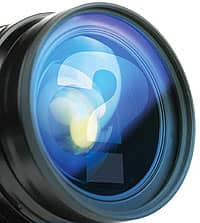by Fred Friedman, Matt Glasgold, and Mike McKenna
Three experts give their views on whether your practice needs a single-lens reflex or point-and-shoot camera

Fred Friedman, Clinipix
There are a variety of cameras available to the orthodontist, ranging from the simple “point and shoot” type to the more sophisticated SLR cameras with a macro lens and a ring light. There is no single camera that can be said to be “the best.” The “best” comes down to what will give you and your staff the results that best suits your needs. The camera you select must be user-friendly and yield high-quality images. We feel that Canon cameras fill this need best.
The point and shoot cameras are generally small, light, and easily handled by both staff and orthodontist. When properly modified for dental use, they can be an effective tool that will yield quite good results over the spectrum of orthodontic requirements, from facial to intraoral views. While these cameras can be had at high megapixel ratings, they do not have the optical quality of a true macro lens, nor do they have the smaller f-stops found on macro lenses. These cameras are auto-focus only. Therefore, images taken of the same patient on each visit may not necessarily be exactly the same for comparison purposes.
Cameras of this type generally do not have eye-level viewfinders and focusing is done from a rear LCD screen. A high-quality camera should have a grid screen for easy horizontal/vertical positioning of the patient. Flash is built into the camera body; ring lights cannot be attached. With proper technique, shadows can be kept to a minimum.

Today’s digital SLR camera bodies are smaller and considerably lighter than previous models, most have the ability to focus through the eye-level finder or the rear LCD, they have 10 to 18 megapixels or more, and some record high-definition video. The digital SLR body is only as good as the remaining components necessary to complete the working system: the lens and lighting.
The macro lens is a most important aspect of the system. Optical quality, ease of focusing, and f-stop range are important factors. The required focusing ability should be a range from 1:1 through the full face/profile view without the addition of any accessories. The 105-mm macro lens should be the lens of choice, and can be used manually or in autofocus mode. Manual focus gives the photographer the ability to record images at exact distances. To achieve this, the lens should have markings indicating the images to be photographed: buccal, smile, occlusal, facial. All one has to do is rotate the lens to the desired view, move toward the subject until the image is seen sharply in the viewfinder or the rear LCD screen, and press the shutter button. Each subsequent photo will be taken at exactly the same distance, ensuring identical magnification and visual comparison, regardless of who may be taking the photos.
To complete this type of system, the proper type of lighting is the last component. For high-quality, color-accurate images, a dedicated ring light is highly recommended.
Finally, the choice should be based on which type of camera the orthodontist and/or the staff find most comfortable, and which will give the best quality needed for their purposes.
Matt Glasgold, Lester A. Dine

An orthodontist can’t simply walk into a camera shop and buy a camera to take pictures inside the mouth. There are very specific parameters that have to be met in order for a camera to function intraorally.
So how does an orthodontist choose the right camera? There are two different categories: digital SLRs and digital handheld cameras. Each offers features that make them appealing.
Digital SLRs use a macro lens and an intraoral flash to take photos. As was the case with film-based cameras, the lens and flash play a much more important role in the quality of photograph than the camera body itself. Digital SLR bodies generally range from 10 MP to 17 MP resolution, with negligible quality difference between cameras despite a fairly wide range of resolution options. Different camera bodies have different features that may be appealing to users (such as autofocus and live video). In terms of the actual photo output, orthodontists do not need the fanciest and highest-resolution camera to take the best picture. The Canon Rebel XS (10 MP) and the Nikon D5000 (12 MP, also capable of recording high-resolution video) are examples of affordably priced lightweight cameras.
The true quality differences come into play with lens and flash. The 105-mm macro lens is traditionally considered the ideal lens for dental photography; the lens can photograph subjects from two to three teeth intraorally to portraits. The 105-mm lens can be easily used to standardize photography. Dental photography companies go so far as to place a guide on the lens that notes the ideal spot to set the lens for each popular orthodontic photograph, making the process of taking before-and-after photos as simple as possible.
A 60-mm macro lens is also an option for orthodontic photography. It is slightly smaller and lighter than the 105-mm macro lens, but it must perform its photography from closer to the subject than the 105 mm, which could be uncomfortable for some patients. On the flip side, the 60-mm lens is closer to the subject for facials (roughly 5 feet versus 6 feet with the 105-mm lens), making the 60-mm lens a better choice for users in a small work environment. The barrel of the 60-mm lens is not conducive to a standardization guide.
Users absolutely want to avoid using nonmacro lenses such as the 18- to 55-mm lens often included in digital camera kits, as they often have significant depth of field and distortion issues.
The absolute key to orthodontic photography is intraoral lighting. The ring flash is designed to fully illuminate the dark cavern that is the mouth. It works for occlusal photography as well as anterior and buccal picture-taking.
A variety of ring-style flashes are on the market, but few are what’s called through the lens (TTL) meterable. TTL means the camera is able to read lighting around the subject through its lens and output the right amount of flash based on this reading. TTL is designed to make patient photographs as consistent as possible regardless of changes in environmental lighting.
Some orthodontic kits also include a point flash, which complements the ring flash by producing an angled light designed to show off shape and contour. Users can choose between the ring and point flashes with the flip of a switch. The point flash most accurately shows off the face and how the nose, lips, and jawline relate to one another. The point flash can also be used for anterior and buccal picture-taking, as the angled light creates shadowing to better show crowding of teeth.
Handheld digital cameras provide instant access to images, but over the counter they lack the proper flash and lens system to photograph the orthodontic subject acceptably. A variety of dental companies have tried different solutions, from screw-on lenses that can add magnification to the lens but sacrifice depth of field and don’t solve the lighting issue, to reflectors that can help illuminate inside the mouth, but add bulk to what should be a simple camera. Often the reflectors have to be removed from the cameras for portraits.
With the number of facial photographs that orthodontists take, it might not make sense to complicate small and simple cameras to that extent.
Another solution is a handheld digital camera modified internally. Modified handheld cameras are designed to light the intraoral subject properly, and the firmware of the camera has been modified to avoid the need for changing setting from intraoral to facial photography. These cameras do not require a ring flash. The photography is generally done from roughly 6 to 8 inches from the subject. The key is the camera’s ability to meter the close-up flash, something over-the-counter cameras cannot do.
With most handheld cameras, the photography is done via live running video screen. This technique is very much the same as the way personal handheld digital cameras are used, so its use should be familiar to virtually every staff member who owns a personal digital camera.
So how does an orthodontist choose a camera?
1) Photo quality: If picture quality has to be the absolute best, than digital SLRs are the right choice.
2) Ease of use: The size and weight of handheld digital cameras, especially those without large add-on accessories, make them a much less intimidating camera and more conducive to use by multiple staff members.
3) Standardization: If taking absolutely standardized “before” and “after” pictures is a priority, than Digital SLRs are likely the choice. It is generally recommend that SLR cameras be used in manual focus, setting the lens to the same spot for the same photos, so before-and-afters or case-progress photos look side-by-side accurate. Handheld digital cameras are generally used in an autofocus mode, which makes it more difficult to take absolutely standardized photos.
4) Pricing: For practices on a budget, a handheld digital camera will definitely be the best value. The right handheld digital will take excellent orthodontic photos and likely be priced close to $1,000 less than its digital SLR counterparts.
5) Customer Service: Dental camera companies exist as a niche business because the needs of dental photographers are unique. Choose a camera from a company that you know will be available to answer your questions during the life of your camera, because invariably settings get altered, instructions get lost, and new staff require training.
Mike McKenna, PhotoMed
There are many things to consider when choosing a camera for intraoral photographs. One of the first choices many offices make is whether to choose an SLR camera or a smaller “point and shoot” (P&S) model.
SLR digital cameras have interchangeable lenses and flashes so that the camera can be configured specifically for whatever type of photography you are doing. For intraoral shots, you need a high-quality macro lens that allows you to shoot a small field and a compatible macro flash that fully illuminates that small field.
P&S cameras are most commonly used as recreational cameras due to their small size and weight. The lens and flash of a P&S are fixed and cannot be removed. With proper accessories (such as a custom close-up kit), there are some P&S cameras that can take high-quality intraoral views, but the vast majority are not capable of taking quality intraoral photos.
For orthodontic records, the anterior, buccal, and occlusal views should all be taken at the same lens magnification so that the teeth in all five photos are the same size. Modern orthodontic software makes it fairly easy to adjust the individual images if they are not taken consistently, but this adds time when arranging the images. If they were all taken at the same magnification, you can simply drop the images into the software and be finished.
The macro lenses of SLR cameras have magnification markings on the barrel of the lens. This allows every staff member who takes photos to use the same lens magnification and get consistent, repeatable results.
A few P&S models feature custom modes that give you the option to “lock in” a lens position and get the same consistent image sizing that SLRs give you.
The traditional macro lens used for dental photos is a 100-mm macro lens, but the best SLR lens choice for orthodontic photography is a 60-mm macro lens. This lens puts the photographer at a more comfortable working distance from the patient than a 100-mm macro lens does. It also makes it easier if a staff member is shooting alone and also holding a mirror or a retractor.
Canon and Nikon feature a range of SLR camera bodies, and they both offer choices in macro lenses and macro flashes. Sigma is the largest independent camera manufacturer, and they make macro lenses and a macro flash that work with Nikon and Canon cameras. Be sure to choose a flash made by a major manufacturer. They are more reliable and work better with the cameras than flashes that have been modified or adapted after the fact.
If you choose a P&S camera, look for one that uses optical zoom over digital zoom. Optical zoom uses the physical lens on the camera to allow you to change the amount of the field that you photograph. Digital zoom is an electronic gimmick that makes it appear that the camera can focus in closer than the lens is designed to, but in doing so, you lose a considerable amount of image quality.
Finally, regardless of which type of camera you choose, make sure that the company you work with is knowledgeable about dental photography and that it stands behind the camera. Is unlimited phone support included? What about a loaner camera if yours is dropped? Does it offer a return policy without fees or restocking charges?
Fred Friedman is president of Clinipix. He can be reached at
Matt Glasgold is vice president of Lester A. Dine Inc. He can be reached at
Mike McKenna is vice president of PhotoMed. He can be reached at







